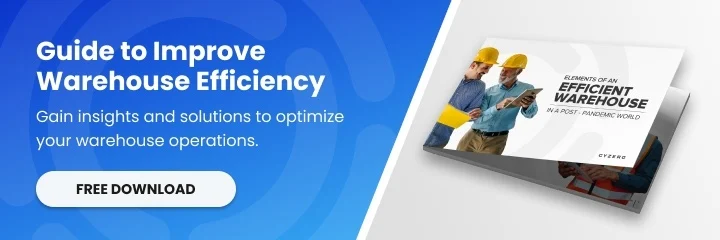For more information about reducing warehouse costs or the latest warehouse technology trends, you can follow us on LinkedIn, YouTube, X, or Facebook. If you have other inquiries or suggestions, please contact us here. We’ll be happy to hear from you.
Warehouse costs can eat into your profit margins and limit your competitive edge. Controlling these operating costs is essential for any warehouse, large or small. This guide covers the main types of warehouse costs and proven strategies to reduce them. Learn how to optimize inventory management, streamline processes, leverage technology, and make data-driven decisions to cut costs and boost profitability.
Click Here: Boost Your Warehouse Efficiency With This Advanced and Affordable WMS
Whether you’re a small business owner or a warehouse manager in a large organization, these tips can be implemented to significantly impact your profitability. So, if you’re ready to improve your warehouse operations and increase your profits, read on to learn all you need to know about warehouse costs and how to reduce them.
What are Warehousing Costs?
Warehousing costs refer to the expenses incurred in operating and maintaining a warehouse or storage facility for goods and products. These costs can vary significantly based on factors such as the type of goods being stored, the size of the facility, its location, and the specific services offered. Warehousing costs can be broken down into several categories:
1. Labor Costs
Hiring and managing personnel to handle inventory management, order picking, packing, shipping, receiving, and general maintenance contributes significantly to warehousing costs. Labor costs can be fixed (salaries, benefits) and variable (overtime, temporary staff during busy seasons).

2. Storage Costs
These expenses encompass the physical storage of goods within the warehouse. They include costs for shelving, pallets, racks, bins, and any specialized storage equipment required for specific types of products.
3. Inventory Costs
Holding inventory in a warehouse ties up capital and incurs additional costs. This includes costs related to maintaining the condition of the inventory, such as climate control or specialized storage for sensitive items. There are also costs associated with inventory carrying, including opportunity costs and the risk of obsolescence.
4. Technology Costs
Warehouses increasingly rely on technology for efficient inventory management and order processing. Costs might include warehouse management systems (WMS), barcode scanners, RFID technology, and other automation tools.
5. Equipment Costs
Includes the cost of purchasing and maintaining warehouse equipment, such as forklifts, conveyor belts, pallet jacks, and other equipment necessary to operate efficiently.
6. Maintenance and Repairs
Regular warehouse facility and infrastructure maintenance is essential to ensure operational efficiency and safety. This might involve repairs to machinery, roofing, plumbing, electrical systems, and more.
7. Administrative Costs
These costs cover administrative and managerial functions associated with the warehouse, including office space, administrative staff salaries, and other overhead costs.
8. Security and Safety Costs
Protecting inventory from theft, damage, and other risks is crucial. Security measures might include surveillance systems, alarm systems, security personnel, and safety equipment. Implementing safety protocols and compliance with regulations can also lead to additional costs.
9. Packaging and Handling Costs
Costs related to packaging materials, labeling, and more are also part of warehousing expenses.
The Biggest Warehouse Costs & How to Control Them
The two major costs associated with warehouses are labor and inventory carrying costs.
Labor costs include salaries, wages, benefits, and other compensation for the workforce involved in various warehouse operations.
Inventory carrying costs encompass the expenses incurred by holding and managing inventory within the warehouse. These costs include storage costs (rent, utilities, shelving), capital costs tied up in inventory, insurance premiums to protect stored goods, potential obsolescence costs, and opportunity costs associated with tying up financial resources in inventory instead of investing elsewhere.
Labor and inventory carrying costs are crucial considerations for optimizing warehouse operations and cost efficiency. Balancing these costs while maintaining high service levels and minimizing waste is essential for achieving profitability and customer satisfaction.
The Importance of Reducing Warehouse Costs
Running a warehouse is not just about storing products and fulfilling orders. It’s about operating efficiently and effectively to keep costs down and profits up. By reducing warehouse costs, you can allocate resources to other business areas, invest in growth opportunities, and ultimately increase the business’s bottom line.
Another key benefit of reducing warehouse costs is that it allows you to remain competitive in a rapidly changing market. With increasing customer expectations and growing competition, finding ways to cut costs without compromising quality is essential. By implementing the right strategies, you can create a more efficient and cost-effective warehouse that can deliver products faster, reduce errors, and improve customer satisfaction. So, let’s dive into the top strategies that will help you reduce warehouse costs and maximize your profits.
6 Strategies to Reduce Warehouse Costs
Here are several strategies that can help in reducing warehouse costs:
1. Streamlining Inventory Management
Inventory management is a critical aspect of warehouse operations that can significantly impact your costs and profitability. Poor inventory management can lead to overstocking, stockouts, high carrying costs, and increased order fulfillment time. By streamlining your inventory management processes, you can reduce costs, boost efficiency, and increase customer satisfaction.

Start by conducting a thorough inventory audit to identify obsolete or slow-moving inventory. By eliminating excess stock, you can free up valuable warehouse space, reduce carrying costs, and minimize the risk of stockouts. Implementing a just-in-time (JIT) inventory management system can also help you optimize your inventory levels and reduce costs. JIT allows you to receive inventory from suppliers just in time to fulfill customer orders, eliminating the need for excessive stockpiling.
Investing in a warehouse management system can also help you streamline your processes and reduce costs. These software solutions can track inventory levels, automate ordering, and provide real-time visibility into your stock levels. By automating manual tasks and reducing human error, you can improve efficiency, reduce costs, and improve the accuracy of your inventory records.
2. Optimizing Warehouse Layout and Organization
The layout and organization of your warehouse can significantly impact your costs and productivity. An inefficient layout can lead to wasted time, increased labor costs, and decreased overall efficiency. By optimizing your warehouse layout and organization, you can reduce costs, improve workflow, and increase productivity.
Start by analyzing your current layout and identifying any bottlenecks or inefficiencies. Look for areas where you can streamline processes, eliminate unnecessary steps, and improve the flow of goods. For example, placing frequently picked items closer to the shipping area can reduce travel time and improve order fulfillment speed. Implementing a systematic storage system, such as ABC analysis, can also help you organize your inventory and reduce picking and restocking time.
Investing in warehouse automation technologies, such as conveyor systems or automated guided vehicles (AGVs), can also help you optimize your warehouse layout and reduce costs. These technologies can automate repetitive tasks, reduce labor costs, and improve overall efficiency. By optimizing your warehouse layout and organization, you can reduce costs, improve productivity, and maximize your profits.
3. Implementing Automation and Technology Solutions
In today’s digital age, implementing automation and technology solutions is no longer a luxury but a necessity. Automation can help you streamline warehouse operations, reduce costs, and increase efficiency. Automating manual tasks can free up employees’ time to focus on more value-adding activities, improve accuracy, and reduce errors.
One area where automation can have a significant impact is order fulfillment. Implementing a warehouse management system (WMS) can help you automate order processing, picking, and packing, reducing labor costs and improving order accuracy. Additionally, by using barcode scanning and automated sorting systems, you can minimize errors and improve order fulfillment speed.
Another area where automation can be beneficial is inventory management. An automated inventory tracking system can help reduce stockouts, eliminate excess inventory, and improve accuracy. These systems use RFID or barcode scanning to track inventory in real time, giving you better visibility into your stock levels and making data-driven decisions.
Investing in technology solutions, such as cloud-based software or mobile applications, can also help you improve communication and collaboration within your warehouse. By providing real-time updates and easier access to information, you can improve efficiency, reduce errors, and minimize delays.
4. Implementing Lean Principles
Lean principles can be applied to warehouse operations to reduce waste, improve efficiency, and increase profitability. Identifying and eliminating non-value-adding activities can streamline your processes, reduce costs, and improve overall efficiency.
Start by conducting a value stream analysis to identify areas of waste and inefficiency in your warehouse operations. Look for activities that do not add value to your customers and find ways to eliminate or reduce them. For example, unnecessary movement, excess inventory, and overproduction are all forms of waste that can be eliminated or minimized.
Implementing visual management tools, such as kanban boards or 5S methodology, can also help you organize your warehouse, improve efficiency, and reduce costs. These tools provide a visual representation of your processes, making it easier to identify bottlenecks, monitor performance, and identify opportunities for improvement.
Investing in continuous improvement initiatives, such as Kaizen events or Six Sigma projects, can help you identify and eliminate waste. By involving your employees in the improvement process, you can tap into their knowledge and experience to find innovative solutions and make sustainable improvements.
5. Training and Empowering Warehouse Staff
Your warehouse staff plays a crucial role in the success and profitability of your operations. Investing in their training and empowerment can improve productivity, reduce errors, and increase overall cost-efficiency. Well-trained and motivated employees are likelier to take ownership of their work, find innovative solutions, and deliver high-quality results.

Start by conducting a skills assessment to identify any training gaps or areas for improvement. Provide your employees with the necessary training and resources to perform their jobs effectively and efficiently. This can include training on warehouse management systems, inventory control techniques, or equipment operation.
Empowering your employees to make decisions and take ownership of their work is also important for reducing costs and improving efficiency. Encourage them to identify and report any areas for improvement, provide feedback, and participate in problem-solving initiatives.
Recognizing and rewarding your employees’ contributions is crucial for maintaining motivation and engagement. Implement a performance-based incentive program that rewards employees for meeting or exceeding productivity targets, reducing errors, or finding cost-saving solutions. Creating a continuous improvement and recognition culture can improve productivity, reduce costs, and maximize profits.
6. Monitoring and Measuring Cost Reduction Efforts
Implementing cost reduction strategies is not a one-time task but an ongoing process. To ensure your efforts’ success, monitoring and measuring your results regularly is essential. By tracking key performance indicators (KPIs) and analyzing your progress, you can identify any deviations, make necessary adjustments, and stay on track toward your cost reduction goals.
Start by identifying the most relevant KPIs for your warehouse operations. This can include metrics such as inventory turnover, order fulfillment speed, labor productivity, or picking accuracy. Set realistic targets for each KPI and regularly measure your performance against these targets.
By monitoring KPIs, you can identify where you fall short and take corrective actions to address them. Regularly review your processes, identify bottlenecks or inefficiencies, and implement improvements. By continuously monitoring and measuring your cost reduction efforts, you can ensure that you are on track toward your goals and maximize your chances of success.
Gathering feedback from your employees and customers is essential in addition to KPIs. Communicate regularly with them, solicit their feedback, and incorporate their suggestions into your improvement initiatives. By involving all stakeholders in the process, you can gain valuable insights, uncover hidden opportunities, and make informed decisions.
Analyzing Current Warehouse Expenses
Before implementing cost reduction strategies, you must clearly understand your current warehouse expenses. This involves analyzing your financial statements, tracking your costs, and identifying areas where you are overspending. By conducting a thorough analysis, you can uncover hidden costs, identify inefficiencies, and develop targeted strategies to address them.
Start by examining your fixed and variable costs. Fixed costs include rent, utilities, insurance, and equipment maintenance, while variable costs include labor, packaging materials, and inventory carrying costs. Look for areas where you can negotiate better rates or find alternative suppliers to reduce costs. For example, you might be able to find a cheaper insurance provider or negotiate better payment terms with your suppliers. By analyzing your current warehouse expenses, you can identify areas for improvement and develop a plan to reduce costs and increase profitability.
Analyzing your current warehouse expenses is not a one-time task. It should be an ongoing process that is regularly reviewed and updated. By regularly monitoring your costs, you can identify any changes or trends that may impact your bottom line and take proactive steps to address them. This will help you stay ahead of the competition and ensure your warehouse operations are always cost-effective and efficient.
Conclusion
Streamlining warehouse costs is not just about cutting expenses but about strategically optimizing operations for long-term profitability and efficiency. The strategies, from leveraging technology to empowering your workforce, provide a roadmap for transforming your warehouse operations. By embracing these approaches, businesses can not only see a reduction in costs but also an improvement in operational fluidity and customer satisfaction. As the warehouse plays a pivotal role in the supply chain, investing in these cost-reduction measures can yield significant dividends, positioning your business for success in a competitive marketplace.












